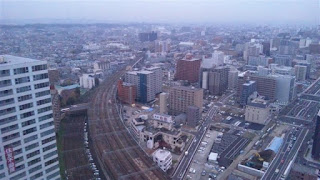On Saturday December 15th the international symposium titled “The
Great East Japan Earthquake’s Lesson on International Cooperation” was held at the
Multimedia Education and Research Complex on Kawauchi Campus. Eight presenters from five different countries
delivered lectures, and about 130 people took part in the symposium. The opening address was made by President
Susumu Satomi, followed by Ms. Emiko Okuyama, the Mayor of Sendai, conveying
her congratulations to Tohoku University.
http://www.tohoku.ac.jp/english/2012/12/news20121226-01.html
http://www.tohoku.ac.jp/english/2012/12/news20121226-01.html
 The first presenter was Dr. Nobuyoshi Hara, Executive Vice President
of Tohoku University. Dr. Hara discussed
how various institutions and research teams from Tohoku University contributed to
disaster reconstruction and regeneration in the affected areas.
The first presenter was Dr. Nobuyoshi Hara, Executive Vice President
of Tohoku University. Dr. Hara discussed
how various institutions and research teams from Tohoku University contributed to
disaster reconstruction and regeneration in the affected areas.
Next was Dr. Holger Finken of DAAD (German Academic Exchange
Service) in Tokyo. Dr. Finken stressed the
importance of academic mobility between Japanese and German universities,
intensive and careful communication required in consideration of legal and
societal conditions, and sustainable funding secured by both sides.
Professor Cheng-Hung Hang of National Cheng Kung University (国立成功大学) in Taiwan not only talked about the responses of the university
after the earthquake on March 11th, but also about concern over the
future of nuclear power and alternative forms of energy.
Ms. Kumiko Tsukamoto is a senior education manager at the Australian
Embassy in Japan. She introduced the strong
bonds in the field of education between both countries, and Australian
governmental support for the areas affected by the earthquake.
Dr. Lalit Acharya, director of international relations of Riverside
City, California, explained about his energetic activities so far as a liaison
between his city and its many sister cities (Sendai is one of them),
universities and high schools. Riverside
City is one of the strongest supporters of Sendai City.
Mr. William McMichael of Fukushima University reported on the
situation in Fukushima then and afterward.
Many foreigners left Fukushima out of fear over radioactivity. Mr.
McMichael did his best to ensure foreign students’ security and took part in
community projects to support students as well as Fukushima itself. He showed various photos of his vigorous activities.
Prof. Onaka of Iwate University and Prof. Suematsu of Tohoku University presented results of surveys conducted at each university. From the results of each, we could see how students at both universities assessed the situation, what actions they took, their thoughts, and so on.





































